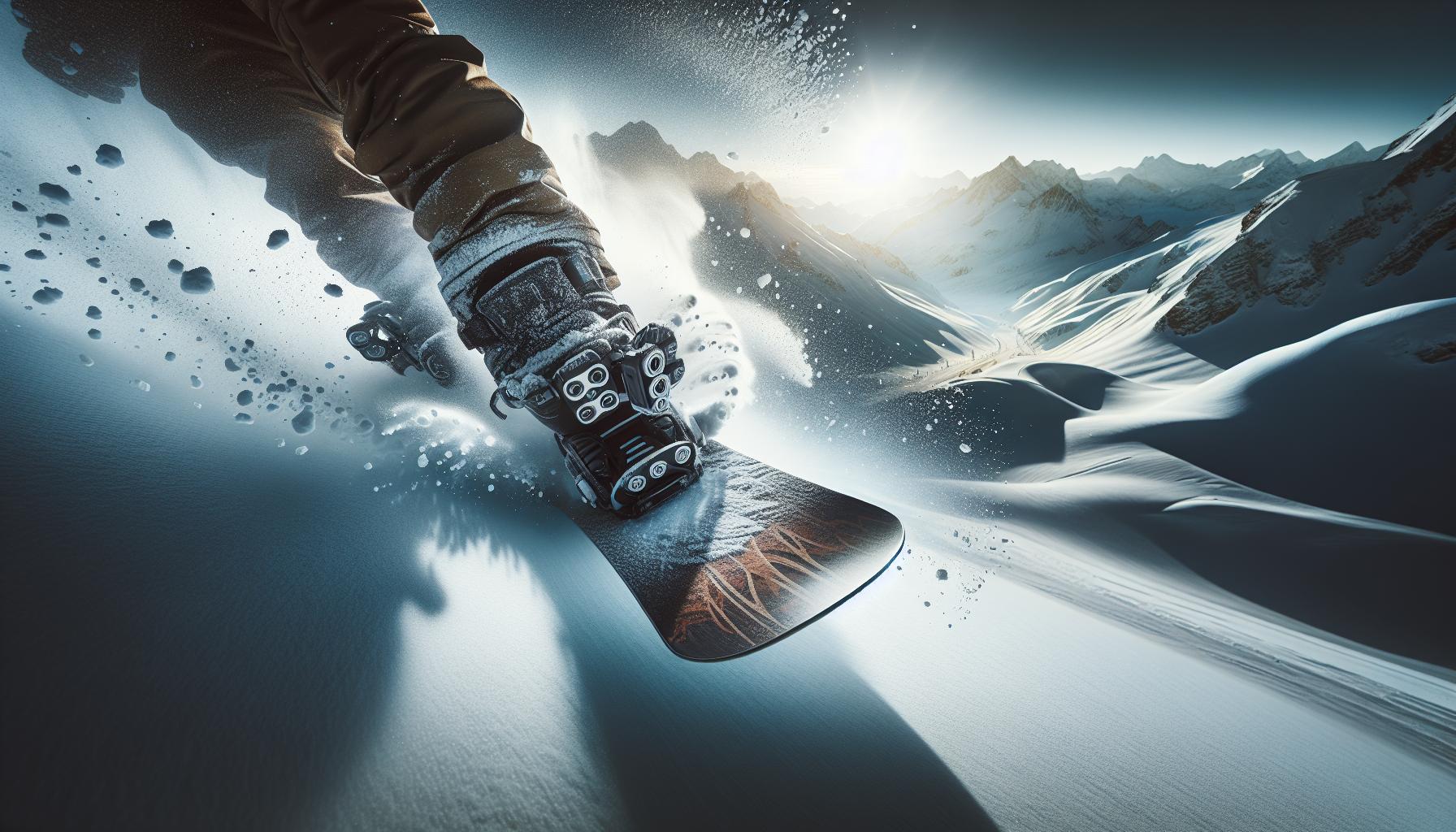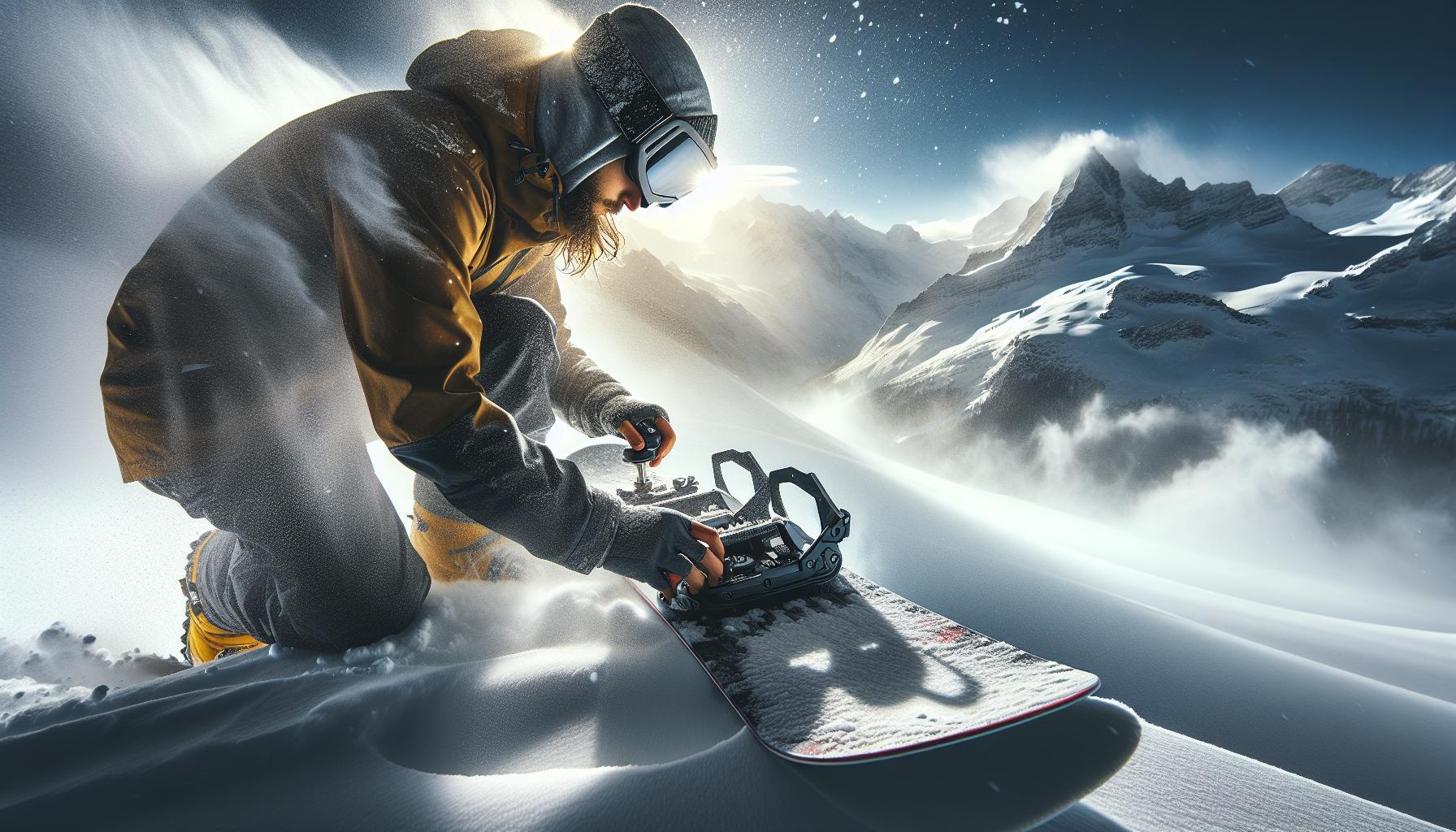Finding yoru footing on the slopes can be challenging, especially when navigating smooth snowboard surfaces. Enter stomp pads: essential traction accessories that enhance control and stability, making lifts and tricky terrain easier to handle. Understanding their role is vital for both novice and seasoned riders, ensuring a safer, more enjoyable snowboarding experience.
Understanding the Role of Stomp Pads in Your Snowboarding Setup
The Importance of Stomp Pads in your Snowboarding Setup
Every snowboarder knows the importance of maintaining control on the slopes, and stomp pads are essential for achieving that stability and grip, especially when strapping in or waiting on a lift. These simple but effective accessories provide extra traction for your back foot, allowing you to keep your board steady while you balance or maneuver. Without a stomp pad, riders can find themselves slipping and struggling to maintain control, which can greatly affect performance and safety.
When it comes to choosing the right stomp pad, consider the type of material and design that best suits your needs. For example, rubber stomp pads are known for their excellent grip and durability, making them a popular choice among many riders. Alternatively, transparent pads can offer a sleek look without distracting from board graphics.Here are some types of stomp pads to consider:
- Textured Pads: These often provide the best grip,as their surface area is designed to catch the boot.
- Stud Pads: With raised bumps or studs, these pads offer a low-profile solution without compromising on traction.
- Large Mats: Covering a larger area of the board, they ensure stability for both feet but may add weight.
Choosing the Right stomp Pad for Your Riding Style
In selecting the ideal stomp pad, it’s essential to evaluate your riding style and the conditions you’ll be facing. As an example, if you frequently find yourself in icy conditions, a pad with more aggressive spikes may be beneficial. On the other hand, if you enjoy powder conditions, a sleek and lightweight pad could be preferable for performance.Here’s a swift comparison of different stomp pad types:
| Stomp Pad Type | Best For | Foot Traction | Weight |
|---|---|---|---|
| Textured Rubber | all-Mountain | High | Medium |
| Stud Design | Parks and Jumps | moderate | Low |
| Large Mats | Freeride | High | High |
Regardless of the type you choose, ensure that the stomp pad is securely mounted to your board. A well-installed pad will not only enhance your riding experience but also contribute to your overall safety on the slopes. By understanding the role of stomp pads and investing in the right one for your snowboarding setup,you ensure a more enjoyable ride and greater control in various terrain and conditions.
How to Choose the Right Stomp Pad for Your Riding Style
Consider Your Riding Style
when selecting a stomp pad, understanding your riding style is crucial. Are you a freestyler who thrives in parks,or do you prefer carving down groomed trails? Different styles demand varying levels of traction and pad shapes. For example, freestyle riders often benefit from smaller, more flexible stomp pads that allow for greater agility during tricks, while all-mountain enthusiasts might opt for larger, more aggressive textured pads that provide superior grip when navigating diverse terrains.
Material Matters
The material of your stomp pad can considerably affect performance and durability. Most stomp pads are made from either rubber or thermoplastic materials. Rubber pads often offer a softer feel and greater grip, which can be beneficial for those who value comfort and control.In contrast, thermoplastic options usually deliver superior durability and resistance to abrasion, making them a great choice for riders who frequently skate to and from lifts in all weather conditions. consider how the stomp pad’s material interacts with the bottom of your boots and adjust your choice based on what feels right during trial runs.
Design & Size Considerations
A variety of designs are available, from traditional flat pads to innovative 3D shapes that provide added traction. These designs can influence how effectively the pad grips your boot. Here are a few design types to consider:
- Flat Pads: Ideal for all-mountain riders, offering a classic look and versatility.
- Stud Design: Popular among freeriders, these pads feature raised spikes for enhanced grip without adding bulk.
- Transparent Pads: Perfect for those who want a subtler look, integrating well with any board design.
The size of the stomp pad also plays a critical role. A larger stomp pad can provide more grip,which is notably useful for beginners still mastering balance.However, experienced riders may prefer a smaller pad that allows for more foot movement and flexibility.
Adhesive Strength
the adhesive strength is a vital aspect that should not be overlooked. A stomp pad with super strong adhesive will ensure it stays in place, even through the wildest rides and conditions. Be sure to look for pads that specify high-quality adhesion; this will prevent the frustration of trying to realign or replace a pad that’s become dislodged after just a few sessions.
when searching for the right stomp pad, consider your riding style, the materials, design options, size, and the adhesive quality. These factors together can greatly enhance your snowboarding experience by ensuring you can ride confidently during any adventure on the slope.
Installation Tips: Perfecting Your Stomp Pad Placement
Choosing the Right Spot for Your Stomp Pad
Finding the perfect placement for a stomp pad is crucial for optimal traction when snowboarding. The key is to visualize how you stand on the board, especially during one-footed maneuvers or when getting off the lift. Begin by cleaning the board’s surface thoroughly; any dust or residue can affect adhesion. Following this, take a moment to consider where your foot naturally lands on the board. Placing the stomp pad too far forward or backward can lead to sloppy dismounts or reduced grip.
To help with precision, use painter’s tape to mark your desired location. This temporary measure allows you to rearrange the pad sideways or back and forth until it feels just right. Remember, you typically get one shot at applying the adhesive, so it’s better to take the time to get it perfect now than to face the hassle later.
Preparing for Application
Planning is essential before you apply your stomp pad. Warm the board slightly in a cool environment, especially if it’s been sitting in the cold. This can be done with a hair dryer on a low setting—be cautious not to overheat and damage the board’s material. A warm surface helps the adhesive stick better, enhancing the longevity and effectiveness of your stomp pad.
After ensuring the surface is clean and warm, peel off the backing of your stomp pad carefully to avoid any dirt contamination. Align it with your tape markings and press down firmly, ensuring no air bubbles are trapped underneath. This enhances grip and keeps everything secure.
Allow Time to Cure
Once the stomp pad is applied, be patient. It’s vital to let the adhesive cure properly. Avoid riding the board for at least a couple of hours, or as recommended by the pad’s manufacturer, to ensure it bonds well with the surface. This downtime is crucial for achieving optimal performance, allowing you to feel confident and secure while navigating the slopes.
By following these installation tips, you’ll ensure your stomp pad serves its purpose effectively, making your snowboarding experience smooth and enjoyable. Don’t underestimate the comfort and safety provided by well-placed stomp pads; they can make a meaningful difference in your overall performance on the mountain.
Boosting Your Confidence: The Impact of Stomp pads on Performance
Experiencing a slip while maneuvering on your snowboard can be daunting, especially on steep inclines or crowded lifts. This is where stomp pads emerge as essential tools that significantly enhance your confidence on the slopes. By providing crucial traction between your boot and the board, stomp pads transform your riding experience, making it both safer and more enjoyable.
When selecting stomp pads, consider their design and material quality, as these factors directly impact performance. High-quality stomp pads feature textured surfaces that grip your boot effectively, minimizing the risk of slipping. As an example, options with molded spikes or stud designs not only ensure superior traction but also maintain a low profile, allowing for seamless transitions from the lift to riding without cumbersome interference. Some of the best stomp pads incorporate materials that are lightweight yet durable, like thermoplastic, which withstands the rigors of snowboarding while offering excellent grip without damaging your clothing or gloves.
- Enhanced Control: A reliable stomp pad aids in controlling your snowboard while you’re off the lift, giving you the confidence to push off and navigate turns more effectively.
- Improved Safety: With better traction, snowboarders can focus on their performance instead of worrying about slips, especially in icy conditions.
- Boosted Performance: Confidence gained from consistent grip allows riders to execute turns and tricks with greater conviction, leading to improved overall performance.
Real-world examples highlight the impact stomp pads can have on performance. Many seasoned snowboarders attest to the difference a quality stomp pad made in their riding; for instance, a skateboarder turned snowboarder was able to connect with the board more intuitively after installing a textured pad. This added grip not only improved their ability to balance but also contributed to a more fluid riding style,allowing them to tackle diverse terrains with assurance.
embracing the benefits of stomp pads can elevate your snowboarding experience significantly. With the right stomp pad, you can ride with confidence, knowing that you have the traction needed for optimal performance, regardless of the conditions.
Stomp Pads vs. Other Traction Solutions: What’s Best for You?
Understanding Your Traction Options
When it comes to maintaining control and stability on your snowboard, traction solutions are vital.While snowboard stomp pads are a popular choice, several other options exist, each with its own set of advantages. Choosing the right solution can significantly impact your performance on the slopes. Let’s explore the differences between stomp pads and option traction methods, helping you decide which is best for your snowboarding needs.
stomp Pads: the Traditional Choice
Stomp pads are widely regarded as essential traction game-changers in the snowboarding community. These pads provide a textured surface that enhances grip when you need to secure your back foot while strapping in or getting on and off lifts. They come in various shapes, sizes, and materials, allowing for customization based on personal preference and riding style. Advantages of stomp pads include:
- Improved grip in all snow conditions
- Ease of installation and removal
- Durability against wear and tear
- Variety in design and colour for personalization
Alternative Traction Solutions
While stomp pads are the go-to option for many riders, other traction solutions can also enhance your performance on the slopes. These include traction strips, spray-on traction, and grip wax. Here’s a brief overview:
| Traction Solution | Pros | Cons |
|---|---|---|
| Traction Strips | customizable, minimalistic | May require careful placement |
| Spray-on Traction | Easy application, good for temporary needs | May wear off quickly, less durable |
| Grip Wax | Integrated solution, enhances board grip | Can be uneven, requires regular reapplication |
Finding What Works for You
Ultimately, the choice between stomp pads and other traction solutions boils down to your personal preference and riding style. consider factors like the type of terrain you frequent, your skill level, and how much time you spend getting on and off lifts. Stomp pads might be ideal for those who prioritize grip and ease of use, while alternatives may offer unique benefits for specific riding styles.
Whether you stick with the traditional stomp pad or experiment with innovative traction solutions, ensuring adequate grip on your snowboard is crucial for enhancing your performance and safety on the slopes. Always remember to test your chosen solution prior to tackling complex runs, allowing you to ride confidently and with full control.
Care Tips for Your stomp Pads: Keeping Grip Strong All Season long
To ensure optimal performance throughout the snowboarding season, maintaining your stomp pads is crucial. These essential traction game-changers play a significant role in providing grip when you’re not strapped in, especially during those critical moments getting on and off lifts.Over time, stomp pads can accumulate dirt, snow, and ice, which can diminish their effectiveness. Here are some practical tips to keep your stomp pads in peak condition.
- Regular Cleaning: Rinse your stomp pads with warm water after each day of riding to remove any debris or ice that may have built up. Avoid using harsh chemicals as they can degrade the materials of the stomp pad.
- Avoid Excessive Force: When scraping off snow or ice, use a soft brush or cloth.Aggressive scraping can lead to scratches or dents that may affect grip.
- Inspect for Wear and Tear: Regularly check your stomp pads for any signs of wear. Look for cracks or peeling edges. If any damage is noticeable, it might be time for a replacement to ensure you don’t compromise your safety.
- Temperature Awareness: Be mindful of the temperatures during your rides. Extreme cold can make some materials brittle, while warmth may soften them. Adjust your riding style accordingly to prevent needless stress on the stomp pads.
storage Tips
Storing your snowboard properly during the off-season is just as vital.Avoid stacking items on top of your board to prevent pressure on the stomp pads. Consider using a board bag that offers protection without compressing any of its components.
Keeping your stomp pads in excellent condition not only enhances your ride but also extends their lifespan, allowing you to enjoy maximum grip all winter long. Taking these steps ensures you’re always ready for the next adventure on the slopes!
Riding Surfaces and Conditions: How Stomp Pads can definitely help You Adapt
When navigating varied riding surfaces and conditions on the slopes, having reliable traction becomes a necessity, and stomp pads play a critical role in enhancing your snowboarding experience. These small, often overlooked accessories are essential game-changers that provide the grip needed to stabilize your board, making them invaluable whether you’re riding on icy trails, powder, or packed snow.
Adapting to Different Riding Surfaces
Stomp pads are particularly effective on slick or icy surfaces where maintaining balance can be challenging. A well-placed stomp pad allows riders to step securely on their board when getting off lifts, ensuring a smooth transition and preventing embarrassing slips or falls. In deeper powder conditions, stomp pads help you push against the board to maintain balance while shifting weight between your feet or when performing tricks. Their textured surfaces create friction, allowing snowboards to respond accurately to your movements—essentially making them an extension of your body.
Types of stomp Pads for Varied Conditions
Choosing the right stomp pad can significantly enhance your performance based on the surface conditions. Different designs cater to specific needs:
- Traditional solid Pads: Ideal for most conditions, offering stable traction and durability.
- Stud-design Pads: Perfect for icy surfaces as they provide superior grip without a bulkier profile.
- Transparent Pads: Great for aesthetic compatibility with your board while still delivering a robust grip.
| Type of Stomp Pad | Best For | Features |
|---|---|---|
| Traditional Solid Pads | All-around use | Durability and excellent grip |
| Stud-design Pads | Icy conditions | Low-profile, high traction |
| Transparent pads | Aesthetic boards | Discreet yet functional |
By understanding how stomp pads enhance grip and stability under various conditions, snowboarders can select the right type to suit their riding style and the challenges of the terrain. Adapting your gear to fit each unique environment not only boosts your performance but also enhances safety, allowing you to focus on enjoying the ride.
Personalizing Your Stomp Pad: style Meets Function on the Slopes
Enhancing Your Ride with Custom Stomp Pads
The thrill of snowboarding is not just about mastering tricks or carving down slopes; it’s also about expressing your unique style. A snowboard stomp pad offers an prospect to blend aesthetics with functionality, providing necessary traction while allowing you to personalize your gear. A well-chosen stomp pad not only enhances your control on the board but also showcases your personality. From vibrant colors to captivating designs, the options are endless.
when selecting a stomp pad, consider both the design and material.Popular choices like the Dakine Modular Mat offer both durability and a sleek look, while the Devembr Snowboard Stomp Pad stands out with its attractive snowflake pattern. Here are some important factors to keep in mind:
- Texture: Choose pads with a textured surface for optimal grip.
- Size: Ensure the pad is adequately sized to fit your boot and provides the right amount of coverage.
- Design: Look for designs that resonate with you—be it a minimalist style or a bold graphic.
Customizing for Performance and Style
Installing a stomp pad is not just about function; it’s also an opportunity for creativity. You can opt for models with interchangeable designs or colors that allow you to switch it up whenever you feel like it. Such as, layering multiple stomp pads can create a unique look while providing additional grip. A simple swap can refresh your snowboard’s appearance and can even affect your riding style by switching the pad’s placement based on your preferences.
Here’s how to personalize your stomp pad for both function and flair:
| Feature | Benefit |
|---|---|
| Custom Designs | Showcase your personality while enhancing grip. |
| Size Options | provides the right fit for various boot sizes, ensuring security and comfort. |
| Easy Installation | Modify your snowboard as needed without extensive tools or expertise. |
By thoughtfully selecting and customizing your stomp pad, you can elevate your snowboarding experience, ensuring that every ride is both gripping and reflective of your personal style. Whether you’re on the slopes for performance or pleasure, a well-chosen stomp pad serves as a crucial link between your foot and board, making every descent smoother and more stylish.
Frequently asked questions
What Are Stomp Pads for Snowboarding: Essential Traction Game-Changers?
Stomp pads are traction devices affixed to the top of a snowboard, located between the bindings. They provide grip for your rear foot, helping to maintain control and stability when getting on and off the chairlift or when riding one-footed.
These pads are essential for snowboarding because they prevent your foot from slipping on the board, especially when it’s wet or icy. Different materials and designs are available, allowing riders to choose based on personal preference.
How Do I Choose the Right Stomp Pad for My Snowboard?
When choosing a stomp pad, consider the material, size, and design. Popular materials include rubber and foam,which offer good traction and comfort.
Look for a pad that fits your snowboard’s dimensions and matches your riding style. Check out this complete guide for more insights into choosing the perfect stomp pad.
Why Use a Stomp Pad Instead of Riding Without One?
Using a stomp pad enhances your stability and confidence while snowboarding. It helps prevent foot slippage and makes mounting and dismounting lifts easier.
Without a stomp pad, your foot can slide around, leading to potential falls or loss of balance. This becomes even more critical in icy conditions, where traction is compromised.
can I Ride without a Stomp Pad on My Snowboard?
Yes, you can ride without a stomp pad, but it’s not recommended for beginners. Riding without one can compromise your stability and control.
While experienced riders may manage without, stomp pads significantly enhance your riding experience by keeping your foot secure, especially when cruising or navigating tricky terrain.
What Are the Benefits of Installing a Stomp Pad?
The benefits of installing a stomp pad include improved grip, increased control, and enhanced safety during rides.
Stomp pads help you execute turns with more precision and make it easier to maneuver your board when getting on and off lifts.They also provide extra confidence when making quick adjustments on the slopes.
How Do I Properly Install a Stomp Pad?
To install a stomp pad, clean the snowboard surface, peel off the backing, and adhere the pad between your bindings.
It’s crucial to ensure the pad is positioned where your rear foot naturally rests. Some riders prefer to apply it before first use,while others might adjust it after a few rides to find the *perfect spot*.
What Are the Common Types of Stomp Pads Available?
Common types of stomp pads include rubber,foam,and adhesive designs. each type offers unique levels of traction and durability.
Rubber pads, as an example, often have intricate designs that provide excellent grip, while foam pads offer a softer touch. Your choice should depend on your personal riding style and the conditions in which you typically ride.
Insights and Conclusions
As we wrap up our exploration of stomp pads—those unsung heroes of snowboard traction—it’s clear they are essential for every rider, no matter your skill level. Whether you’re hitting the slopes for the first time or gearing up for your next big descent, a good stomp pad can enhance your stability, ease of ride, and overall enjoyment on the mountain. Dive into the world of stomp pads and discover how different shapes, materials, and adhesion techniques can elevate your ride. Don’t just take our word for it; explore various styles and find the one that speaks to your unique snowboarding vibe. From slick designs that fit seamlessly into your board’s aesthetic to spiked pads that provide grip even in the iciest conditions,there’s a stomp pad out there to match every rider’s preference. So strap in, feel the thrill, and make that next ride your best yet! For more tips, insights, and product recommendations, keep shredding and exploring—your perfect snowboarding experience awaits!








